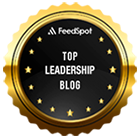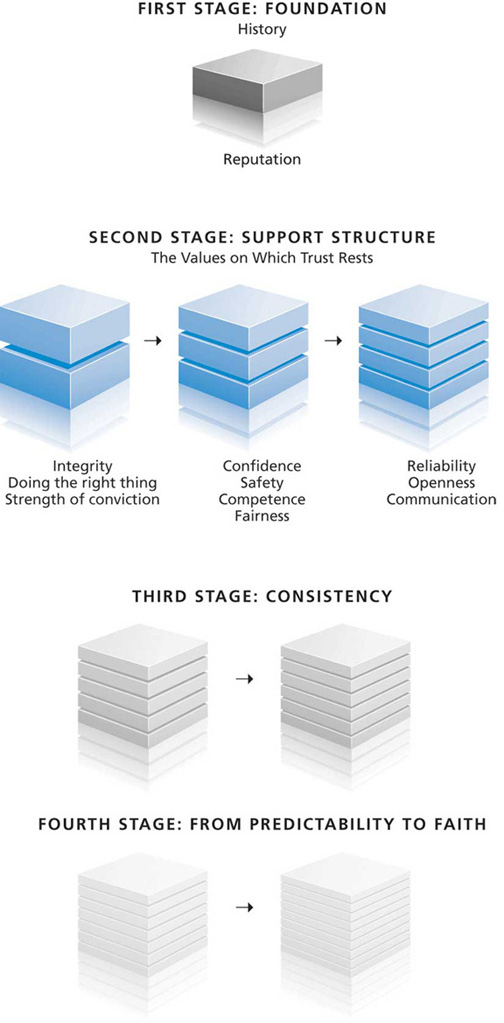Trust must be carefully constructed, vigorously nurtured, and constantly reinforced. Trust is established over time, gradually, through a long chain of successful experiences.
Building trusting relationships is a process that can best be described as stacking layers on a foundation one at a time in such a way that each layer bonds on top of the prior one before another layer is added. This model is described in Creating Trust: A Step-By-Step Guide.
The second stage represents values that lead to trusting relationships, such as integrity, reliability and openness. Once these characteristics are demonstrated, they form the support structure of a trusting relationship.
Second Stage of Trust: The Support Structure
At the start of any relationship, people consciously or unconsciously examine actions rather than words to measure trustworthiness. As time goes by, the more that values such as integrity, fairness, and reliability are evident, the more people learn to trust one another. The more such qualities are recognized, the deeper the trust and, as long as nothing happens to change those first impressions, the stronger the relationship grows.
Integrity. There are a number of questions you ask yourself when assessing someone’s integrity. Do they have a good value system? Are they honest, straightforward, and nonmanipulative? Do they tell the truth and keep their promises even if circumstances have changed since they gave their word? Do they avoid even the appearance of impropriety, and are they aware that the company they keep can be a reflection on their own integrity? Do they pay as much attention to the spirit of the law as they do to the letter of the law?
The same questions apply to organizations. Do they stand behind their products? How do they treat their employees and vendors? Are they good corporate citizens? Do they satisfy their commitments?
Doing the right thing. Another characteristic we look for when building relationships is whether people or organizations do the right thing not because they’re afraid of being caught, but because it’s the right thing to do. Do employees do what is politically expedient and beneficial for themselves or what is in the best interests of their companies, their clients, or their colleagues? Do they exaggerate claims to win the sale, or do they present the pitfalls as well as the benefits?
One good way to look at this is to follow the Golden Rule: “Do unto others as you would have them do unto you.” Doing the right thing may include giving of yourself, without any expectation of personal gain, or exceeding client expectations even if there isn’t any opportunity for additional business. It may mean addressing a problem before it becomes public and you are asked to correct it—even if it represents significant financial exposure.
People who always want to do the “right thing” sometimes face difficult decisions. For example, how much are they willing to tell a prospective client about their misgivings about their own product? Is holding back the truth to protect another individual doing the right thing? There is no set answer to these questions. Everyone has to draw the line for themselves.
Strength of conviction. Another set of questions to ask yourself when determining trustworthiness is: How ethical are the people or organizations I’m dealing with? Do they have strong values? Do they stand up for what they believe in? Are they afraid to present their opinions to upper management? Do they feel comfortable breaking bad news when it is necessary to do so?
Basically, strength of conviction translates into standing up for the things that you believe in. This may include telling clients what they really need to hear instead of what you think they want to hear. Although they may disagree with you or even fault you for challenging them at the moment, they will respect you for speaking your mind and not being a “yes” person. It may include requesting from your organization the resources that you need to properly serve your clients. It may also include not selling or recommending products or services that are not in a prospect’s best interests, even if you are under pressure to increase sales.
Confidence. It is important to determine whether the people you build relationships with are comfortable enough to admit their faults and errors. Ask yourself: Do they always have to be right? Do they listen to suggestions? Are they afraid to admit mistakes? If they cause a problem, do they try to find a way to fix it, or do they look for people to blame?
Safety. When deciding whether to put your trust in someone, you try to discover if they are calm, patient, and logical. You ask yourself whether they have a lot of emotional highs and lows. When conflicts arise, do they act in a caring and responsible fashion? Do they resolve problems and make decisions on the basis of logic, or do they make emotional judgments based on bias, residual anger, or desire to avenge the past?
Companies can demonstrate that they are safe by the strength of their balance sheets, by the length of time that they have been in business, and by their history as a forward-looking organization. Spending on research and development and remaining at the cutting edge over a long period send a strong signal to the marketplace. It’s comforting to know that companies that invest in research and development will continue to enhance their current technology, develop new products and services, and be there to serve your needs in the future.
Companies can also demonstrate safety by such diverse factors as the level of employee turnover (a sign of good management and employee satisfaction); whether products have been abandoned in the past, leaving customers out in the cold; or the level of their sales support and the quality of their marketing materials.
Competence. Trust is increased when an individual is believed to be competent. An advanced degree, an affiliation with a well-respected organization or an organization with a reputation for its thorough training, and professional status, all enhance the trustworthiness of an individual to some degree. These are indicators of a limited amount of competence, but they don’t guarantee competence. Salespeople can increase their level of trust by demonstrating their familiarity with a product, their ability to address product questions, their prior experience in resolving a client issue, and their in-depth knowledge of the prospect’s industry—but nothing is as useful in building trust as satisfactory work.
Organizations that have strong recruiting and education programs have greater trust levels. When organizations are known for aggressive hiring practices and solid training, rather than for throwing employees in the water and watching them swim, trust is enhanced. When employees know that their peers are well trained, they know they can depend on them, that they will receive high-quality information, and that they do not have to fend for themselves.
Fairness. Peter Drucker has said, “The leaders who work most effectively, it seems to me, never say ‘I.’ And that’s not because they have trained themselves not to say ‘I.’ They don’t think ‘I.’ They think ‘we’; they think ‘team.’ They understand their job to be to make the team function. They accept responsibility and don’t sidestep it, but ‘we’ gets the credit. . . . This is what creates trust, what enables you to get the task done.”
How much we trust other people or organizations often has a lot to do with our perception of their fairness; in other words, the belief we have in their objectivity, their lack of prejudice, their impartiality. Are they objective? Do they show bias or favoritism? Do they present both sides of an issue or spin the issue to their advantage? Are they open-minded and willing to listen to new ideas? Do they give everyone the time of day, or are their minds already made up? Do they give credit where credit is due, or do they accept credit for other people’s efforts? Do they have reasonable expectations? Do they know when someone tried to do their best and praise them for their efforts, or do they reprimand them for failure to perform? In the face of disagreement, do they respect the opinions of others or do they attack them, embarrassing, reprimanding, or humiliating them in front of others?
Organizations have demonstrated their fairness by such actions as taking back merchandise with no questions asked or promising that if you find the same merchandise for less money, in 90 days, and can present proof, they’ll pay you the difference.
Reliability. Another quality we look for when deciding whether or not to trust a person or an organization is reliability. We ask such questions as: Are they dependable? Do they follow through on promises made? If you ask for something, can you consider it done? Are they careful not to overstate what they will do? Do they know that even a perceived promise places their honor on the line? Do they exaggerate sales claims or set impossible expectations? Even though a company may have little direct control over the outcome, a promise made can result in a promise broken. Be wary of promises such as these: the product will be fixed by Tuesday; the service person will be there in an hour; you can expect at least an 8 percent return on your investment; even though I haven’t had a chance to look at your tax return, you’ll probably get the same refund as last year; take this medicine and you’ll feel better in an hour; the product never breaks down the first year.
Organizations can demonstrate their reliability by showing that their interest lies more in building long-term customer relationships than in selling a product; they can enhance your satisfaction by ensuring that the owner’s manual is clear, that the service force is well trained, that critical parts are not back-ordered, and that customer complaints are handled promptly.
Openness. Openness in relationships is built upon some existing level of trust. You feel comfortable confiding in people, knowing they would never breach your confidence or use the information against you at a later date. If they respond to that openness as expected, trust is enhanced and intimacy and honesty grow.
Secretiveness. The opposite of openness is secretiveness, and it has the opposite effects. Organizations that deliberately build barriers between themselves and their employees or their clients will never develop relationships based on mutual trust. It does not matter whether secrecy is demonstrated by isolating top management from employees, building barbed wire around the boss’s office, using one-way communication (top-down), or distancing management from clients by hiding them in an ivory tower.
Communication. Communication is viewed as an essential quality that creates high-trust organizations. Lack of communication is particularly harmful when relevant information is withheld in order to maintain control or gain personal advantage.
Organizations lack trust if employees have to weigh and measure everything they hear––if they can’t trust the information that is given them. In organizations marked by trust, employees don’t ask themselves: Am I being kept informed? Will they inform me of a decision that may affect me or let me find out by chance? If they are unwilling or unable to live up to a client promise, will they let me know in a timely fashion so that I can inform my clients? Would they intentionally try to misrepresent what I said? Do they tell everyone the same story? Managers display trust when they openly communicate with their employees and reveal information that they don’t have to.
The opposite of open communication occurs in organizations marked by low levels of trust. According to Dale E. Zand, in such organizations, managers who do “not trust others will conceal or distort relevant information . . . withhold facts, disguise ideas, and conceal conclusions. [Such managers] will hide feelings that increase exposure to others. As a result, [such managers] provide incomplete, untimely information that inaccurately portrays reality.”
These, however, are all problems that can be avoided through the careful use of communication. Effective communication can also have a great impact on trust levels with clients. For example, trust is increased when clients are given advance notice of bad news so that expectations are controlled, when the downside of a product is presented along with its benefits, and when the competition is treated objectively without being denigrated.
In our next post, we’ll hone in on the fourth stage: “Trust: How to Earn Someone’s Faith.”
Thanks for reading. As always, comments and sharing are appreciated.
Additional Reading:
Creating Trust: A Step-By-Step Guide
How to Build Trust: Creating the Foundation
Trust: How to Earn Someone’s Faith
Trust Me: 55 Ways to Build Trust and Credibility
If you like this article, subscribe to our blog so that you don’t miss a single post. Get future posts by RSS feed, email or Facebook. It’s FREE. Click your favorite option (top right).







Frank – I love that you started this post with a visual of a foundation and built up from there! Simple, powerful, and so true!
Thanks Chery
Many people believe trust develops on its own. My hope is that the diagram breaks trust down to its simplest elements. It demonstrates that everything we say and do strengthens or weakens trust.
Have an awesome day!
Best,
Frank
Dear Frank Sonnenberg,
Your name matches your smile.
Your writing is frighteningly exact. There are societies, or people to whom these things don’t matter. I work with them. They seemingly put up with “it” and don’t mind. BUT as you point out so very correct… the structure which builds trust is eroding just the same. I am tempted, with your kind permission to copy this and translate it, and forward this incredible article. Please if you would take the time to respond and explain what you allow me to do, I would be grateful.
I am very grateful having read this; and quitting is not possible nor my intent.
Maiti
Hi Maiti
You’re very kind. Thank you. I’m glad you found the post meaningful enough to translate it. I’ll e-mail you a note.
Have an awesome day!
Best,
Frank
Hello Frank,
I enjoyed reading this post. I liked that you started with simple words which helped me to picture in my mind how important “trust” is for me. I agree with you that we need to build trust. It doesn’t come all of a sudden. It is a work that one needs to do if we are expecting people to trust in us.
By the way, I got to know about you through my class “Personal Branding.” Now, I can’t stop reading your posts. =)
Regards,
Daisy
Hi Daisy
Thanks for your kind words.
Investing in yourself may be the best investment that you’ll ever make. And that begins with learning.You’ll be able to leverage that knowledge for the rest of your life.
I’m so glad that the first post that you read on my site was on trust. It’s at the heart of all relationships. As I like to say, “Trust is like blood pressure. It’s silent, vital to good health, and if abused, it can be deadly.”
Thanks again for taking the time to write. I hope to see you back again soon.
Best,
Frank
Hi Frank, keep posting…I love them all!
Thank you so much, Daisy. I’m so glad you like them. As you may know my mission is simple: To reawaken our commitment to character, values, and personal responsibility. It’s not a business; it’s my passion. Thanks for helping me spread the word 🙂
Best,
Frank
Words and Ideas, have power. Articles as these are treasure troves for building on character and values.
In my company, people are human asset and their building blocks is the mindset that expresses in tangible manners, either by actions or words.
I am now committed to reach each and every one of them.
That’s awesome Eula
Trust and honor mustn’t merely be spoken. They must live in our hearts and be a part of all that we do.
Thanks for taking the time to write.
Best,
Frank
I need your daily newsletters.
Thanks for reaching out Ephaezar. I recommend two options. First, if you’d like, you can receive daily reminders via Facebook. Here’s the link:
https://www.facebook.com/FrankSonnenbergOnline
Second, if you’d like to receive my weekly posts via email, sign up on my blog (top right). Here’s the link:
https://www.franksonnenbergonline.com/
Thanks for taking he time to write.
Best,
Frank